Can Bacteriophages Be Effectively Utilized for Disinfection in Animal-Derived Food Products? A Systematic Review
Abstract
1. Introduction
2. Materials and Methods
2.1. Information Sources and Literature Research
2.2. Study Selection
2.3. Statistical Analysis
3. Results
4. Discussion
5. Conclusions
Supplementary Materials
Author Contributions
Funding
Conflicts of Interest
Abbreviations
| ECDC | European Centre for Disease Prevention and Control |
| CDC | Centre for Disease Prevention and Control |
| TASF | Terrestrial Food of Animal Origin |
| ISO | International Organization for Standardization |
| HACCP | Hazard Analysis & Critical Control Point |
| FDA | Food and Drug Administration |
| PRISMA | Preferred Reporting Items for Systematic reviews and Meta-Analyses |
| IQR | Interquartile Range |
References
- Hutt, P.B.; Hutt, P.B.I. A History of Government Regulation of Adulteration and Misbranding of Food. Food Drug Cosmet. Law J. 1984, 39, 2. [Google Scholar]
- Yun, L.I.O.; Shi, X.M. Food safety regulations within countries of increasing global supplier impact. In Ensuring Global Food Safety: Exploring Global Harmonization; Academic Press: Cambridge, MA, USA, 2022; pp. 151–158. [Google Scholar]
- Food Hygiene. Food Hygiene Fourth Edition, Codex Alimentarius. Available online: https://www.fao.org/4/a1552e/a1552e00.pdf (accessed on 25 February 2020).
- Mead, P.S.; Slutsker, L.; Dietz, V.; McCaig, L.F.; Bresee, J.S.; Shapiro, C.; Griffin, P.M.; Tauxe, R.V. Food-related illness and death in the United States. Emerg. Infect. Dis. 1999, 5, 607. [Google Scholar] [CrossRef] [PubMed]
- WHO. Food Safety. Available online: https://www.who.int/news-room/fact-sheets/detail/food-safety (accessed on 25 February 2020).
- EU. The European Union One Health 2022 Zoonoses Report. Available online: https://www.ecdc.europa.eu/en/publications-data/european-union-one-health-2022-zoonoses-report (accessed on 23 February 2024).
- OECD-FAO. Agricultural Outlook 2021–2030. Available online: https://www.oecd.org/en/publications/oecd-fao-agricultural-outlook-2021-2030_19428846-en.html (accessed on 15 March 2024).
- CDC. Attribution of Foodborne Illness: Findings, Estimates of Foodborne Illness. Available online: https://www.cdc.gov/foodborneburden/attribution/attribution-1998-2008.html (accessed on 26 February 2024).
- FAO. Contribution of terrestrial animal source food to healthy diets for improved nutrition and health outcomes. In Contribution of Terrestrial Animal Source Food to Healthy Diets for Improved Nutrition and Health Outcomes; FAO: Rome, Italy, 2023. [Google Scholar]
- Bonaldo, F.; Avot, B.J.P.; De Cesare, A.; Aarestrup, F.M.; Otani, S. Foodborne Pathogen Dynamics in Meat and Meat Analogues Analysed Using Traditional Microbiology and Metagenomic Sequencing. Antibiotics 2023, 13, 16. [Google Scholar] [CrossRef] [PubMed]
- Roch, F.-F.; Dzieciol, M.; Quijada, N.M.; Alteio, L.V.; Mester, P.-J.; Selberherr, E. Microbial community structure of plant-based meat alternatives. npj Sci. Food 2024, 8, 27. [Google Scholar] [CrossRef]
- Principi, N.; Silvestri, E.; Esposito, S. Advantages and limitations of bacteriophages for the treatment of bacterial infections. Front. Pharmacol. 2019, 10, 513. [Google Scholar] [CrossRef]
- Boyd, E.F. Bacteriophage-encoded bacterial virulence factors and phage-pathogenicity island interactions. Adv. Virus Res. 2012, 82, 91–118. [Google Scholar]
- Emencheta, S.C.; Olovo, C.V.; Eze, O.C.; Kalu, C.F.; Berebon, D.P.; Onuigbo, E.B.; Vila, M.M.D.C.; Balcão, V.M.; Attama, A.A. The Role of Bacteriophages in the Gut Microbiota: Implications for Human Health. Pharmaceutics 2023, 15, 2416. [Google Scholar] [CrossRef]
- Imran, A.; Shehzadi, U.; Islam, F.; Afzaal, M.; Ali, R.; Ali, Y.A.; Chauhan, A.; Biswas, S.; Khurshid, S.; Usman, I.; et al. Bacteriophages and food safety: An updated overview. Food Sci. Nutr. 2023, 11, 3621–3630. [Google Scholar] [CrossRef]
- Lang, L.H. FDA approves use of bacteriophages to be added to meat and poultry products. Gastroenterology 2006, 131, 1370. [Google Scholar] [CrossRef]
- Połaska, M.; Sokołowska, B. Bacteriophages—A new hope or a huge problem in the food industry. AIMS Microbiol. 2019, 5, 324–346. [Google Scholar] [CrossRef]
- PRISMA. PRISMA Statement. Available online: http://www.prisma-statement.org/ (accessed on 23 April 2020).
- Grygorcewicz, B.; Chajęcka-Wierzchowska, W.; Augustyniak, A.; Wasak, A.; Stachurska, X.; Nawrotek, P.; Dołęgowska, B. In-milk inactivation of Escherichia coli O157:H7 by the environmental lytic bacteriophage ECPS-6. J. Food Saf. 2020, 40, e12747. [Google Scholar] [CrossRef]
- Tomat, D.; Soazo, M.; Verdini, R.; Casabonne, C.; Aquili, V.; Balagué, C.; Quiberoni, A. Evaluation of an WPC edible film added with a cocktail of six lytic phages against foodborne pathogens such as enteropathogenic and Shigatoxigenic Escherichia coli. Lwt-Food Sci. Technol. 2019, 113, 108316. [Google Scholar] [CrossRef]
- Kazantseva, O.A.; Skorynina, A.V.; Piligrimova, E.G.; Ryabova, N.A.; Shadrin, A.M. A Genomic Analysis of the Bacillus Bacteriophage Kirovirus kirovense Kirov and Its Ability to Preserve Milk. Int. J. Mol. Sci. 2023, 24, 12584. [Google Scholar] [CrossRef] [PubMed]
- Devlieghere, F.; Vermeiren, L. Efficacy of phage P100 on L. monocytogenes in refrigerated vacuum packaged cooked ham. Fleischwirtschaft 2019, 99, 92–95. [Google Scholar]
- Li, Z.; Ma, W.; Li, W.; Ding, Y.; Zhang, Y.; Yang, Q.; Wang, J.; Wang, X. A broad-spectrum phage controls multidrug-resistant Salmonella in liquid eggs. Food Res. Int. 2020, 132, 109011. [Google Scholar] [CrossRef]
- Esmael, A.; Azab, E.; Gobouri, A.A.; Nasr-Eldin, M.A.; Moustafa, M.M.A.; Mohamed, S.A.; Badr, O.A.M.; Abdelatty, A.M. Isolation and Characterization of Two Lytic Bacteriophages Infecting a Multi-Drug Resistant Salmonella Typhimurium and Their Efficacy to Combat Salmonellosis in Ready-to-Use Foods. Microorganisms 2021, 9, 423. [Google Scholar] [CrossRef]
- Kim, S.; Chang, Y. Anti-Salmonella polyvinyl alcohol coating containing a virulent phage PBSE191 and its application on chicken eggshell. Food Res. Int. 2022, 162, 111971. [Google Scholar] [CrossRef]
- Ahmadi, H.; Barbut, S.; Lim, L.T.; Balamurugan, S. Examination of the Use of Bacteriophage as an Additive and Determining Its Best Application Method to Control Listeria monocytogenesin a Cooked-Meat Model System. Front. Microbiol. 2020, 11, 779. [Google Scholar] [CrossRef]
- Teng, L.; Zou, G.; Zhou, Y.; Li, J.; Song, Z.; Dong, X.; Ma, Z.; Zheng, Z.; Chen, H.; Li, J. Phage controlling method against novel freshwater-derived Vibrio parahaemolyticus in ready-to-eat crayfish (Procambarus clarkii). Food Res. Int. 2022, 162, 111986. [Google Scholar] [CrossRef]
- Wang, S.; Mirmiran, S.D.; Li, X.; Li, X.; Zhang, F.; Duan, X.; Gao, D.; Chen, Y.; Chen, H.; Qian, P. Temperate phage influence virulence and biofilm-forming of Salmonella Typhimurium and enhance the ability to contaminate food product. Int. J. Food Microbiol. 2023, 398, 110223. [Google Scholar] [CrossRef]
- Alves, D.; Marques, A.; Milho, C.; Costa, M.J.; Pastrana, L.M.; Cerqueira, M.A.; Sillankorva, S.M. Bacteriophage φIBB-PF7A loaded on sodium alginate-based films to prevent microbial meat spoilage. Int. J. Food. Microbiol. 2019, 291, 121–127. [Google Scholar] [CrossRef]
- Jung, S.-J.; Ashrafudoulla; Kang, I.; Ha, S.-D. Isolation and characterization of multidrug-resistant Salmonella-specific bacteriophages and their antibacterial efficiency in chicken breast. Poult. Sci. 2023, 102, 103073. [Google Scholar] [CrossRef] [PubMed]
- Li, D.; Zhang, Z.; Li, Y.; Zhang, X.; Qin, X.; Wei, D.; Yang, H. Escherichia coli phage phi2013: Genomic analysis and receptor identification. Arch. Virol. 2022, 167, 2689–2702. [Google Scholar] [CrossRef] [PubMed]
- Zhao, J.; Lin, Y.; Wang, C.; Zayda, M.; Maung, A.T.; Mohammadi, T.N.; Duc, H.M.; Yu, P.; Ma, M.; Gong, D.; et al. Biocontrol of Salmonella Typhimurium in milk, lettuce, raw pork meat and ready-to-eat steamed-chicken breast by using a novel bacteriophage with broad host range. Int. J. Food Microbiol. 2023, 402, 110295. [Google Scholar] [CrossRef] [PubMed]
- Witte, S.; Huijboom, L.; Klamert, S.; van de Straat, L.; Hagens, S.; Fieseler, L.; de Vegt, B.T.; van Mierlo, J.T. Application of bacteriophages EP75 and EP335 efficiently reduces viable cell counts of Escherichia coli O157 on beef and vegetables. Food Microbiol. 2022, 104, 103978. [Google Scholar] [CrossRef]
- Zhou, C.; Zhu, M.; Wang, Y.; Yang, Z.; Ye, M.; Wu, L.; Bao, H.; Pang, M.; Zhou, Y.; Wang, R.; et al. Broad host range phage vB-LmoM-SH3-3 reduces the risk of Listeria contamination in two types of ready-to-eat food. Food Control 2020, 108, 106830. [Google Scholar] [CrossRef]
- Li, T.; Chen, H.; Zhao, J.; Tao, Z.; Lan, W.; Zhao, Y.; Sun, X. Characterization of Phage vB_SalM_SPJ41 and the Reduction of Risk of Antibiotic-Resistant Salmonella enterica Contamination in Two Ready-to-Eat Foods. Antibiotics 2023, 12, 364. [Google Scholar] [CrossRef]
- Duc, H.M.; Son, H.M.; Ngan, P.H.; Sato, J.; Masuda, Y.; Honjoh, K.-I.; Miyamoto, T. Isolation and application of bacteriophages alone or in combination with nisin against planktonic and biofilm cells of Staphylococcus aureus. Appl. Microbiol. Biotechnol. 2020, 104, 5145–5158. [Google Scholar] [CrossRef]
- Sanlibaba, P.; Buzrul, S. Control of Listeria monocytogenes in milk by using phage cocktail. Sci. Agropecu. 2022, 13, 7–14. [Google Scholar] [CrossRef]
- Lee, J.; Kim, D.; Kim, M. The application of adaptively evolved thermostable bacteriophage? YMFM0293 to control Salmonella spp. in poultry skin. Food Res. Int. 2023, 167, 112665. [Google Scholar] [CrossRef]
- Yan, J.; Yang, R.; Yu, S.; Zhao, W. The strategy of biopreservation of meat product against MRSA using lytic domain of lysin from Staphylococcus aureus bacteriophage. Food Biosci. 2021, 41, 100967. [Google Scholar] [CrossRef]
- Nasr-Eldin, M.A.; Gamal, E.; Hazza, M.; Abo-Elmaaty, S.A. Isolation, characterization, and application of lytic bacteriophages for controlling Enterobacter cloacae complex (ECC) in pasteurized milk and yogurt. Folia Microbiol. 2023, 68, 911–924. [Google Scholar] [CrossRef]
- Zou, G.; Ndayishimiye, L.; Xin, L.; Cai, M.; Zhang, L.; Li, J.; Song, Z.; Wu, R.; Zhou, Y.; Shi, Y.; et al. Application of a novel phage LPCS28 for biological control of Cronobacter sakazakii in milk and reconstituted powdered infant formula. Food Res. Int. 2023, 172, 113214. [Google Scholar] [CrossRef] [PubMed]
- Pelyuntha, W.; Vongkamjan, K. Control of Salmonella in Chicken Meat by a Phage Cocktail in Combination with Propionic Acid and Modified Atmosphere Packaging. Foods 2023, 12, 4181. [Google Scholar] [CrossRef] [PubMed]
- Huang, Z.; Yuan, X.; Zhu, Z.; Feng, Y.; Li, N.; Yu, S.; Li, C.; Chen, B.; Wu, S.; Gu, Q.; et al. Isolation and characterization of Bacillus cereus bacteriophage DZ1 and its application in foods. Food Chem. 2023, 431, 137128. [Google Scholar] [CrossRef]
- Gharieb, R.M.A.; Saad, M.F.; Mohamed, A.S.; Tartor, Y.H. Characterization of two novel lytic bacteriophages for reducing biofilms of zoonotic multidrug-resistant Staphylococcus aureus and controlling their growth in milk. LWT 2020, 124, 109145. [Google Scholar] [CrossRef]
- Yan, N.; Xia, H.; Hou, W.; Wang, H.; Wang, H.; Zhou, M. Biological Characterization of Pseudomonas fluorescens Phage Pf17397_F_PD1 and Its Application in Food Preservation. J. Food Prot. 2023, 86, 100125. [Google Scholar] [CrossRef]
- Dechamma, M.M.; Santhosh, K.S.; Maiti, B.; Karunasagar, I.; Karunasagar, I. Application of novel lytic bacteriophages to control Vibrio parahaemolyticus load in seafood. J. Consum. Prot. Food Saf. 2022, 17, 41–49. [Google Scholar] [CrossRef]
- Li, N.; Yuan, X.; Li, C.; Chen, N.; Wang, J.; Chen, B.; Yu, S.; Yu, P.; Zhang, J.; Zeng, H.; et al. A novel Bacillus cereus bacteriophage DLn1 and its endolysin as biocontrol agents against Bacillus cereus in milk. Int. J. Food Microbiol. 2022, 369, 109615. [Google Scholar] [CrossRef]
- Yuan, X.; Zhu, Z.; Huang, Z.; Yu, S.; Jin, H.; Chen, B.; Yu, S.; Xue, L.; Chen, M.; Zhang, J.; et al. Engineered lytic phage of Bacillus cereus and its application in milk. Int. J. Food Microbiol. 2023, 405, 110339. [Google Scholar] [CrossRef]
- Tian, R.; Xu, S.; Li, P.; Li, M.; Liu, Y.; Wang, K.; Liu, G.; Li, Y.; Dai, L.; Zhang, W. Characterization of G-type Clostridium perfringens bacteriophages and their disinfection effect on chicken meat. Anaerobe 2023, 81, 102736. [Google Scholar] [CrossRef] [PubMed]
- Kim, J.H.; Kim, H.J.; Jung, S.J.; Mizan, M.F.R.; Park, S.H.; Ha, S.D. Characterization of Salmonella spp.-specific bacteriophages and their biocontrol application in chicken breast meat. J. Food Sci. 2020, 85, 526–534. [Google Scholar] [CrossRef] [PubMed]
- Shahin, K.; Bao, H.; Zhu, S.; Soleimani-Delfan, A.; He, T.; Mansoorianfar, M.; Wang, R. Bio-control of O157:H7, and colistin-resistant MCR-1-positive Escherichia coli using a new designed broad host range phage cocktail. LWT 2022, 154, 112836. [Google Scholar] [CrossRef]
- Ashrafudoulla Md Kim, H.J.; Her, E.; Shaila Shanjida Park, S.H.; Ha, S.D. Characterization of Salmonella Thompson-specific bacteriophages and their preventive application against Salmonella Thompson biofilm on eggshell as a promising antimicrobial agent in the food industry. Food Control 2023, 154, 110008. [Google Scholar] [CrossRef]
- Shahin, K.; Zhang, L.; Delfan, A.S.; Komijani, M.; Hedayatkhah, A.; Bao, H.; Barazandeh, M.; Mansoorianfar, M.; Pang, M.; He, T.; et al. Effective control of Shigella contamination in different foods using a novel six-phage cocktail. LWT 2021, 144, 111137. [Google Scholar] [CrossRef]
- Cong, C.; Wei, B.; Cui, H.; Li, X.; Yuan, Y.; Wang, L.; Li, S.; Xu, Y. Isolation, characterization and comparison of lytic Epseptimavirus phages targeting Salmonella. Food Res. Int. 2021, 147, 110480. [Google Scholar] [CrossRef]
- Mohammadi, T.N.; Shen, C.; Li, Y.; Zayda, M.G.; Sato, J.; Masuda, Y.; Honjoh, K.-I.; Miyamoto, T. Characterization of Clostridium perfringens bacteriophages and their application in chicken meat and milk. Int. J. Food Microbiol. 2021, 361, 109446. [Google Scholar] [CrossRef]
- Borie-Polanco, C.; Galarce-Gálvez, N.; Yévenes-Coa, K.; Yáñez-López, J.-M.; Robeson-Camus, J.; Carbonero-Martínez, A. Reducing Salmonella enterica serovar Enteritidis contamination in food: Lytic bacteriophages in a homemade mayonnaise-like matrix. Rev. Colomb. Cienc. Pecu. 2020, 34, 154–161. [Google Scholar] [CrossRef]
- Kwak, H.; Kim, J.; Ryu, S.; Bai, J. Characterization of KMSP1, a newly isolated virulent bacteriophage infecting Staphylococcus aureus, and its application to dairy products. Int. J. Food Microbiol. 2023, 390, 110119. [Google Scholar] [CrossRef]
- Islam, M.; Zhou, Y.; Liang, L.; Nime, I.; Liu, K.; Yan, T.; Wang, X.; Li, J. Application of a Phage Cocktail for Control of Salmonella in Foods and Reducing Biofilms. Viruses 2019, 11, 841. [Google Scholar] [CrossRef]
- Choo, K.W.; Mao, L.; Mustapha, A. CAM-21, a novel lytic phage with high specificity towards Escherichia coli O157:H7 in food products. Int. J. Food Microbiol. 2022, 386, 110026. [Google Scholar] [CrossRef] [PubMed]
- Zhang, Y.; Zou, G.; Islam, S.; Liu, K.; Xue, S.; Song, Z.; Ye, Y.; Zhou, Y.; Shi, Y.; Wei, S.; et al. Combine thermal processing with polyvalent phage LPEK22 to prevent the Escherichia coli and Salmonella enterica contamination in food. Food Res. Int. 2023, 165, 112454. [Google Scholar] [CrossRef] [PubMed]
- Islam, M.d.S.; Nime, I.; Pan, F.; Wang, X. Isolation and characterization of phage ISTP3 for bio-control application against drug-resistant Salmonella. Front. Microbiol. 2023, 14, 1260181. [Google Scholar] [CrossRef] [PubMed]
- Zhou, Y.; Wan, Q.; Bao, H.; Guo, Y.; Zhu, S.; Zhang, H.; Pang, M.; Wang, R. Application of a novel lytic phage vB_EcoM_SQ17 for the biocontrol of Enterohemorrhagic Escherichia coli O157:H7 and Enterotoxigenic E. coli in food matrices. Front. Microbiol. 2022, 13, 929005. [Google Scholar] [CrossRef]
- Park, H.; Kim, J.; Kim, M.; Park, Y.; Ryu, S. Development of new strategy combining heat treatment and phage cocktail for post-contamination prevention. Food Res. Int. 2021, 145, 110415. [Google Scholar] [CrossRef]
- Pelyuntha, W.; Vongkamjan, K. Combined effects of Salmonella phage cocktail and organic acid for controlling Salmonella Enteritidis in chicken meat. Food Control. 2022, 133, 108653. [Google Scholar] [CrossRef]
- do Nascimento, E.C.; Sabino, M.C.; da Roza Corguinha, L.; Targino, B.N.; Lange, C.C.; de Oliveira Pinto, C.L.; Pereira Vidigal, P.M.; Sant’Ana, A.S.; Hungaro, H.M. Lytic bacteriophages UFJF_PfDIW6 and UFJF_PfSW6 prevent Pseudomonas fluorescens growth in vitro and the proteolytic-caused spoilage of raw milk during chilled storage. Food Microbiol. 2022, 101, 103892. [Google Scholar] [CrossRef]
- Zhou, Y.; Li, L.; Han, K.; Wang, L.; Cao, Y.; Ma, D.; Wang, X. A Polyvalent Broad-Spectrum Escherichia Phage Tequatrovirus EP01 Capable of Controlling Salmonella and Escherichia coli Contamination in Foods. Viruses 2022, 14, 286. [Google Scholar] [CrossRef]
- Resendiz-Moctezuma, C.; Rezac, S.D.; Miller, M.J.; Stasiewicz, M.J. Enabling Cost-Effective Screening for Antimicrobials against Listeria monocytogenes in Ham. J. Food Prot. 2021, 84, 802–810. [Google Scholar] [CrossRef]
- Cao, Y.; Ma, R.; Li, Z.; Mao, X.; Li, Y.; Wu, Y.; Wang, L.; Han, K.; Li, L.; Ma, D.; et al. Broad-Spectrum Salmonella Phages PSE-D1 and PST-H1 Controls Salmonella in Foods. Viruses 2022, 14, 2647. [Google Scholar] [CrossRef]
- Sun, Z.; Mandlaa; Wen, H.; Ma, L.; Chen, Z. Isolation, characterization and application of bacteriophage PSDA-2 against Salmonella Typhimurium in chilled mutton. PLoS ONE 2022, 17, e0262946. [Google Scholar] [CrossRef] [PubMed]
- Vikram, A.; Tokman, J.I.; Woolston, J.; Sulakvelidze, A. Phage Biocontrol Improves Food Safety by Significantly Reducing the Level and Prevalence of Escherichia coli O157:H7 in Various Foods. J. Food Prot. 2020, 83, 668–676. [Google Scholar] [CrossRef] [PubMed]
- Li, S.; Konoval, H.M.; Marecek, S.; Lathrop, A.A.; Feng, S.; Pokharel, S. Control of Escherichia coli O157:H7 using lytic bacteriophage and lactic acid on marinated and tenderized raw pork loins. Meat Sci. 2022, 196, 109030. [Google Scholar] [CrossRef] [PubMed]
- Park, D.-W.; Park, J.-H. Characterization and Food Application of the Novel Lytic Phage BECP10: Specifically Recognizes the O-polysaccharide of Escherichia coli O157:H7. Viruses 2021, 13, 1469. [Google Scholar] [CrossRef]
- Dewanggana, M.N.; Evangeline, C.; Ketty, M.D.; Waturangi, D.E.; Yogiara; Magdalena, S. Isolation, characterization, molecular analysis and application of bacteriophage DW-EC to control Enterotoxigenic Escherichia coli on various foods. Sci. Rep. 2022, 12, 495. [Google Scholar] [CrossRef]
- Atterbury, R.J.; Gigante, A.M.; Lozano, M.d.l.S.R.; Medina, R.D.M.; Robinson, G.; Alloush, H.; Barrow, P.A.; Allen, V.M. Reduction of Salmonella contamination on the surface of chicken skin using bacteriophage. Virol. J. 2020, 17, 88. [Google Scholar] [CrossRef]
- Hou, Y.; Wu, Z.; Ren, L.; Chen, Y.; Zhang, Y.-A.; Zhou, Y. Characterization and application of a lytic jumbo phage ZPAH34 against multidrug-resistant Aeromonas hydrophila. Front. Microbiol. 2023, 14, 1178876. [Google Scholar] [CrossRef]
- Artawinata, P.C.; Lorraine, S.; Waturangi, D.E. Isolation and characterization of bacteriophages from soil against food spoilage and foodborne pathogenic bacteria. Sci. Rep. 2023, 13, 9282. [Google Scholar] [CrossRef]
- Li, Z.; Li, W.; Ma, W.; Ding, Y.; Zhang, Y.; Yang, Q.; Wang, J.; Wang, X. Characterization and Application of a Lytic Phage D10 against Multidrug-Resistant Salmonella. Viruses 2021, 13, 1626. [Google Scholar] [CrossRef]
- Yan, J.; Yang, R.; Yu, S.; Zhao, W. The application of the lytic domain of endolysin from Staphylococcus aureus bacteriophage in milk. J. Dairy Sci. 2021, 104, 2641–2653. [Google Scholar] [CrossRef]
- Hluchanova, L.; Korena, K.; Juricova, H. Vacuum-Packed Steak Tartare: Prevalence of Listeria monocytogenes and Evaluation of Efficacy of ListexTM P100. Foods 2022, 11, 533. [Google Scholar] [CrossRef] [PubMed]
- You, H.J.; Lee, J.H.; Oh, M.; Hong, S.Y.; Kim, D.; Noh, J.; Kim, M.; Kim, B.S. Tackling Vibrio parahaemolyticus in ready-to-eat raw fish flesh slices using lytic phage VPT02 isolated from market oyster. Food Res. Int. 2021, 150, 110779. [Google Scholar] [CrossRef] [PubMed]
- Brenner, T.; Schultze, D.M.; Mahoney, D.; Wang, S. Reduction of Nontyphoidal Salmonella enterica in Broth and on Raw Chicken Breast by a Broad-spectrum Bacteriophage Cocktail. J. Food Prot. 2023, 87, 100207. [Google Scholar] [CrossRef] [PubMed]
- Phothaworn, P.; Supokaivanich, R.; Lim, J.; Klumpp, J.; Imam, M.; Kutter, E.; Galyov, E.E.; Dunne, M.; Korbsrisate, S. Development of a broad-spectrum Salmonella phage cocktail containing Viunalike and Jerseylike viruses isolated from Thailand. Food Microbiol. 2020, 92, 103586. [Google Scholar] [CrossRef]
- Aguilera, M.; Martínez, S.; Tello, M.; Gallardo, M.J.; García, V. Use of Cocktail of Bacteriophage for Salmonella Typhimurium Control in Chicken Meat. Foods 2022, 11, 1164. [Google Scholar] [CrossRef]
- Shang, Y.; Sun, Q.; Chen, H.; Wu, Q.; Chen, M.; Yang, S.; Du, M.; Zha, F.; Ye, Q.; Zhang, J. Isolation and Characterization of a Novel Salmonella Phage vB_SalP_TR2. Front. Microbiol. 2021, 12, 4810. [Google Scholar] [CrossRef]
- Henderson, L.; Cabrera-Villamizar, L.; Skeens, J.; Kent, D.; Murphy, S.; Wiedmann, M.; Guariglia-Oropeza, V. Environmental conditions and serotype affect Listeria monocytogenes susceptibility to phage treatment in a laboratory cheese model. J. Dairy Sci. 2019, 102, 9674–9688. [Google Scholar] [CrossRef]
- Guo, Y.; Li, J.; Islam, M.S.; Yan, T.; Zhou, Y.; Liang, L.; Connerton, I.F.; Deng, K.; Li, J. Application of a novel phage vB_SalS-LPSTLL for the biological control of Salmonella in foods. Food Res. Int. 2021, 147, 110492. [Google Scholar] [CrossRef]
- Wang, Y.; Li, J.; Wang, Y.; Wu, J.; Wang, X.; Xue, F.; Ren, J.; Dai, J.; Tang, F. Sterilizing effect of phage cocktail against Shiga toxin-producing Escherichia coli O157:H7 in foods. Food Biosci. 2022, 51, 102282. [Google Scholar] [CrossRef]
- García-Anaya, M.C.; Sepulveda, D.R.; Rios-Velasco, C.; Acosta-Muñiz, C.H. Incorporation of A511 bacteriophage in a whey protein isolate-based edible coating for the control of Listeria monocytogenes in Cheese. Food Packag. Shelf Life 2023, 37, 101095. [Google Scholar] [CrossRef]
- Tian, Y.; Wu, L.; Lu, R.; Bao, H.; Zhou, Y.; Pang, M.; Brown, J.; Wang, J.; Wang, R.; Zhang, H. Virulent phage vB_CpeP_HN02 inhibits Clostridium perfringens on the surface of the chicken meat. Int. J. Food Microbiol. 2022, 363, 109514. [Google Scholar] [CrossRef] [PubMed]
- Park, H.; Kim, J.; Kim, H.; Cho, E.; Park, H.; Jeon, B.; Ryu, S. Characterization of the lytic phage MSP1 for the inhibition of multidrug-resistant Salmonella enterica serovars Thompson and its biofilm. Int. J. Food Microbiol. 2022, 385, 110010. [Google Scholar] [CrossRef] [PubMed]
- Shakeri, G.; Hammerl, J.A.; Jamshidi, A.; Ghazvini, K.; Rohde, M.; Szabo, I.; Kehrenberg, C.; Plötz, M.; Kittler, S. The Lytic Siphophage vB_StyS-LmqsSP1 Reduces the Number of Salmonella enterica Serovar Typhimurium Isolates on Chicken Skin. Appl. Environ. Microbiol. 2021, 87, e01424-21. [Google Scholar] [CrossRef]
- Guenther, S.; Huwyler, D.; Richard, S.; Loessner, M.J. Virulent bacteriophage for efficient biocontrol of Listeria monocytogenes in ready-to-eat foods. Appl. Environ. Microbiol. 2009, 75, 93–100. [Google Scholar] [CrossRef] [PubMed]
- CDC. Foodborne Illness Source Attribution Estimates for Salmonella, Escherichia coli O157, and Listeria monocytogenes—United States, 2021 The Interagency Food Safety Analytics Collaboration (IFSAC). 2023. Available online: https://www.cdc.gov/foodsafety/ifsac/projects/index.html (accessed on 13 October 2024).
- Shannon, R.; Radford, D.R.; Balamurugan, S. Impacts of food matrix on bacteriophage and endolysin antimicrobial efficacy and performance. Crit. Rev. Food Sci. Nutr. 2019, 60, 1631–1640. [Google Scholar] [CrossRef] [PubMed]
- Kawacka, I.; Olejnik-Schmidt, A.; Schmidt, M.; Sip, A. Effectiveness of Phage-Based Inhibition of Listeria monocytogenes in Food Products and Food Processing Environments. Microorganisms 2020, 8, 1764. [Google Scholar] [CrossRef]
- Liu, X.; Yao, H.; Zhao, X.; Ge, C. Biofilm Formation and Control of Foodborne Pathogenic Bacteria. Molecules 2023, 28, 2432. [Google Scholar] [CrossRef]
- Borin, J.M.; Lee, J.J.; Gerbino, K.R.; Meyer, J.R. Comparison of bacterial suppression by phage cocktails, dual-receptor generalists, and coevolutionarily trained phages. Evol. Appl. 2022, 16, 152–162. [Google Scholar] [CrossRef]
- Gu, J.; Liu, X.; Li, Y.; Han, W.; Lei, L.; Yang, Y.; Zhao, H.; Gao, Y.; Song, J.; Lu, R.; et al. A Method for Generation Phage Cocktail with Great Therapeutic Potential. PLoS ONE 2012, 7, e31698. [Google Scholar] [CrossRef]
- Mateus, L.; Costa, L.; Silva, Y.; Pereira, C.; Cunha, A.; Almeida, A. Efficiency of phage cocktails in the inactivation of Vibrio in aquaculture. Aquaculture 2014, 424–425, 167–173. [Google Scholar] [CrossRef]
- Russell, A. Lethal effects of heat on bacterial physiology and structure. Sci. Prog. 2003, 86, 115–137. [Google Scholar] [CrossRef]
- Elliott, J.F.K.; McLeod, D.V.; Taylor, T.B.; Westra, E.R.; Gandon, S.; Watson, B.N.J. Conditions for the spread of CRISPR-Cas immune systems into bacterial populations. ISME J. 2024, 18, wrae108. [Google Scholar] [CrossRef]
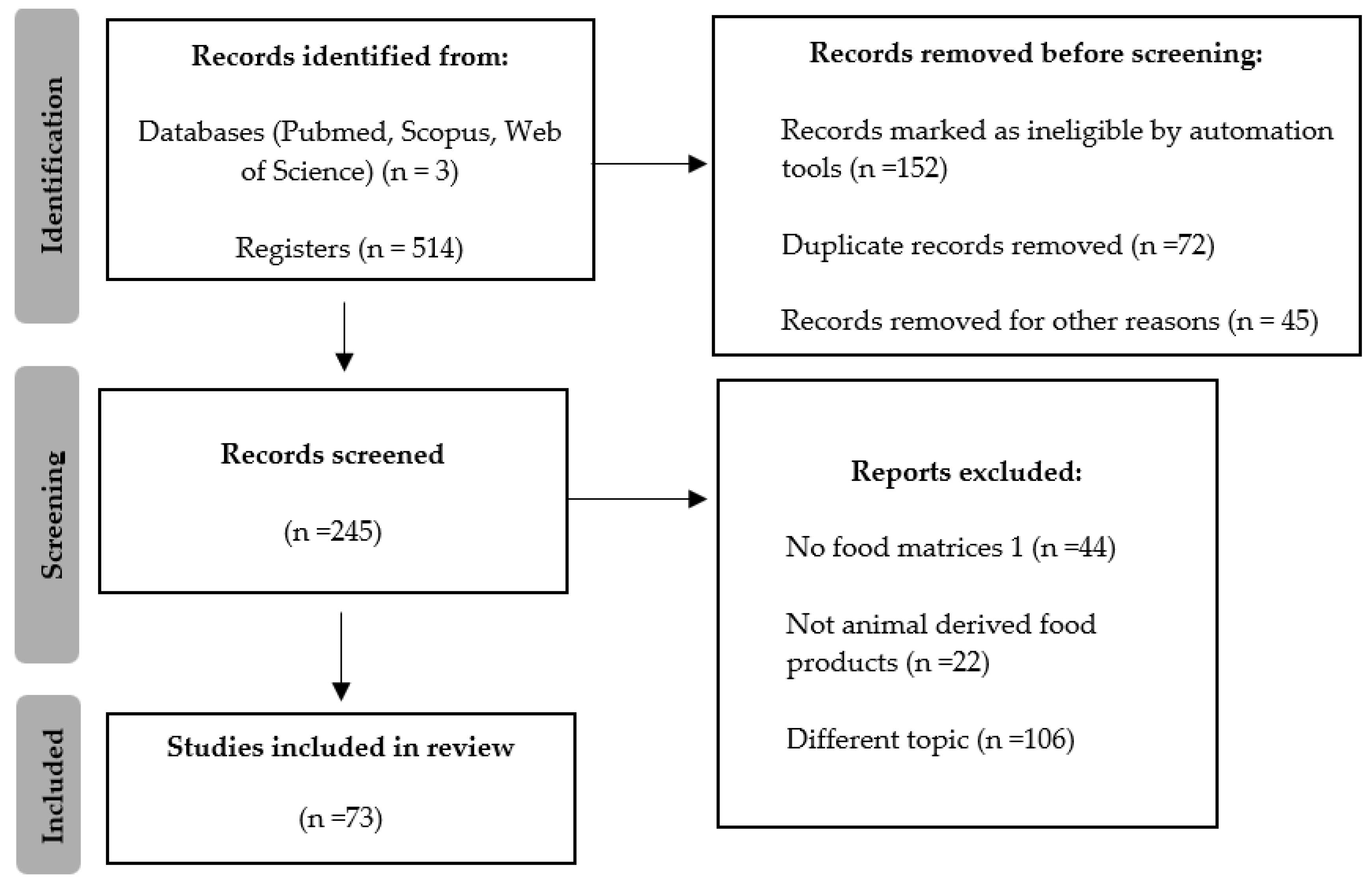
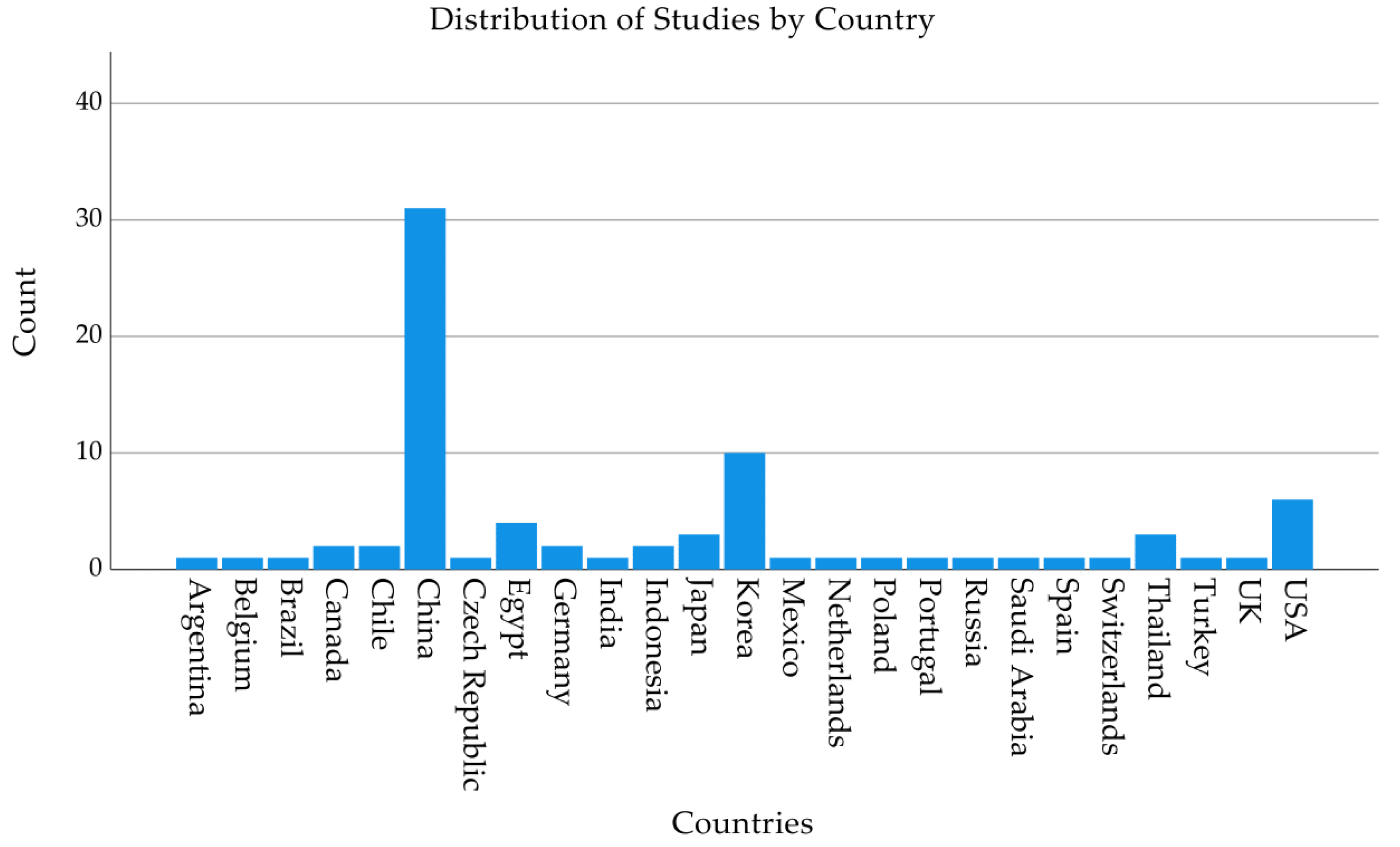
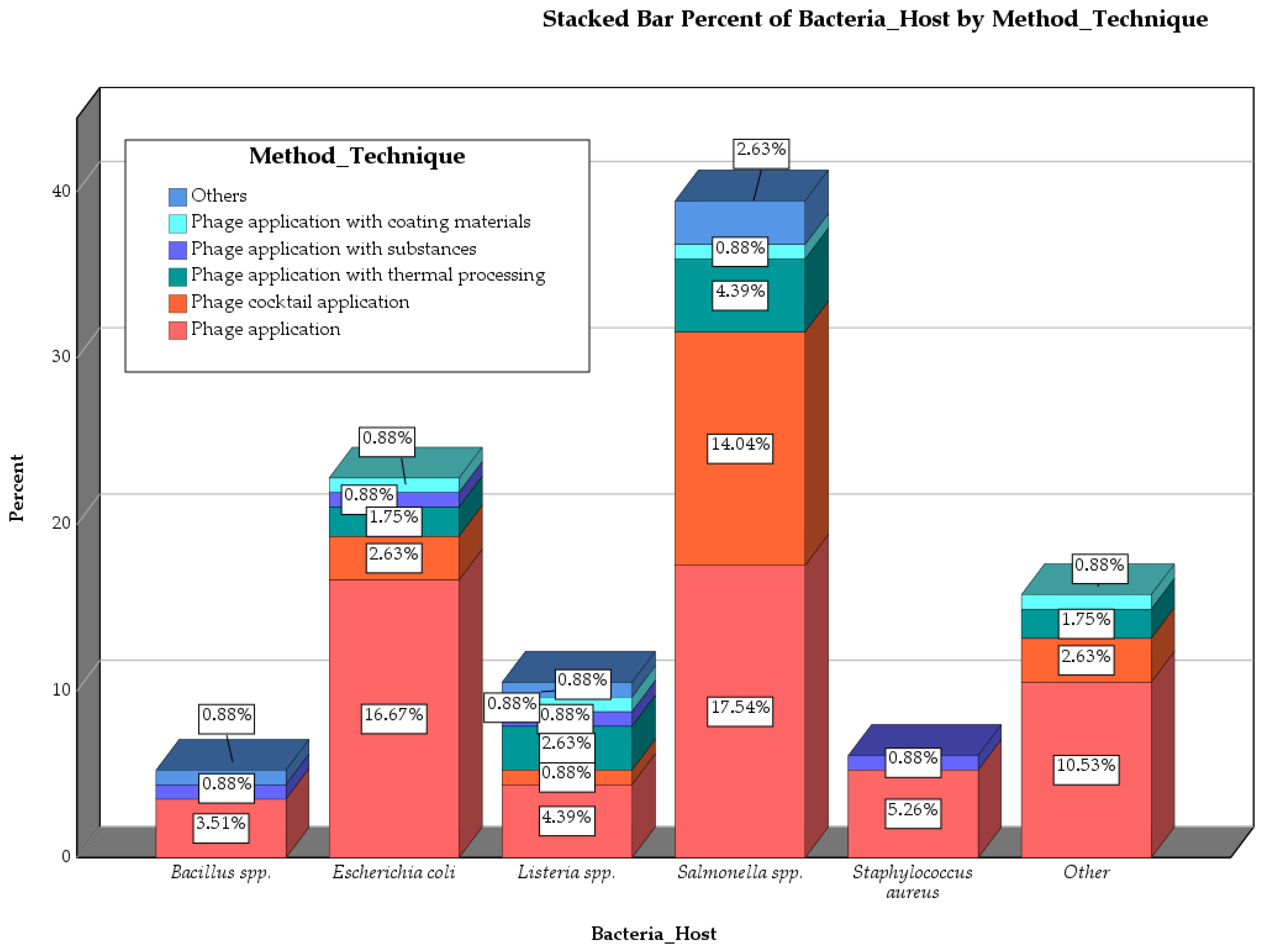
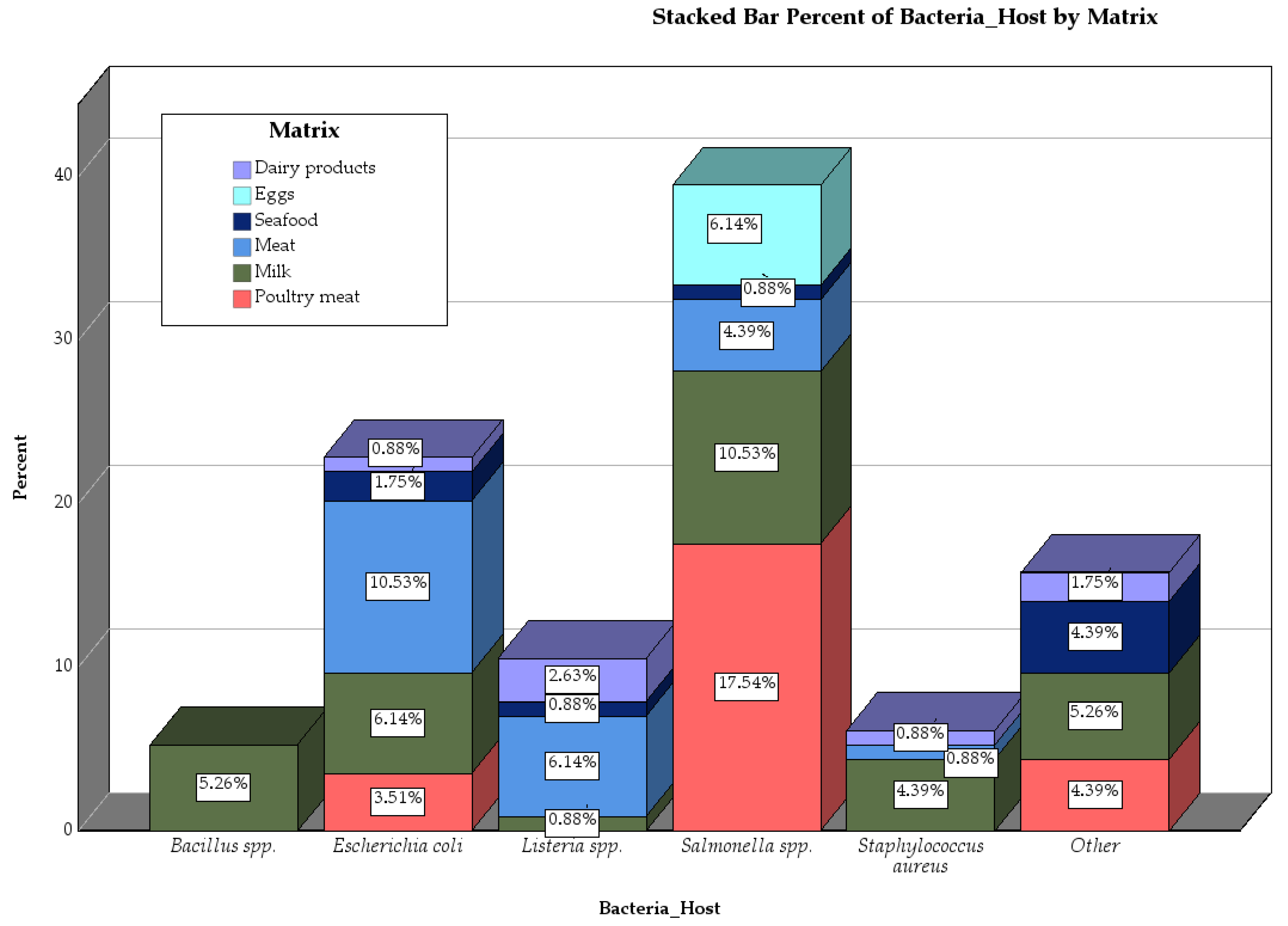
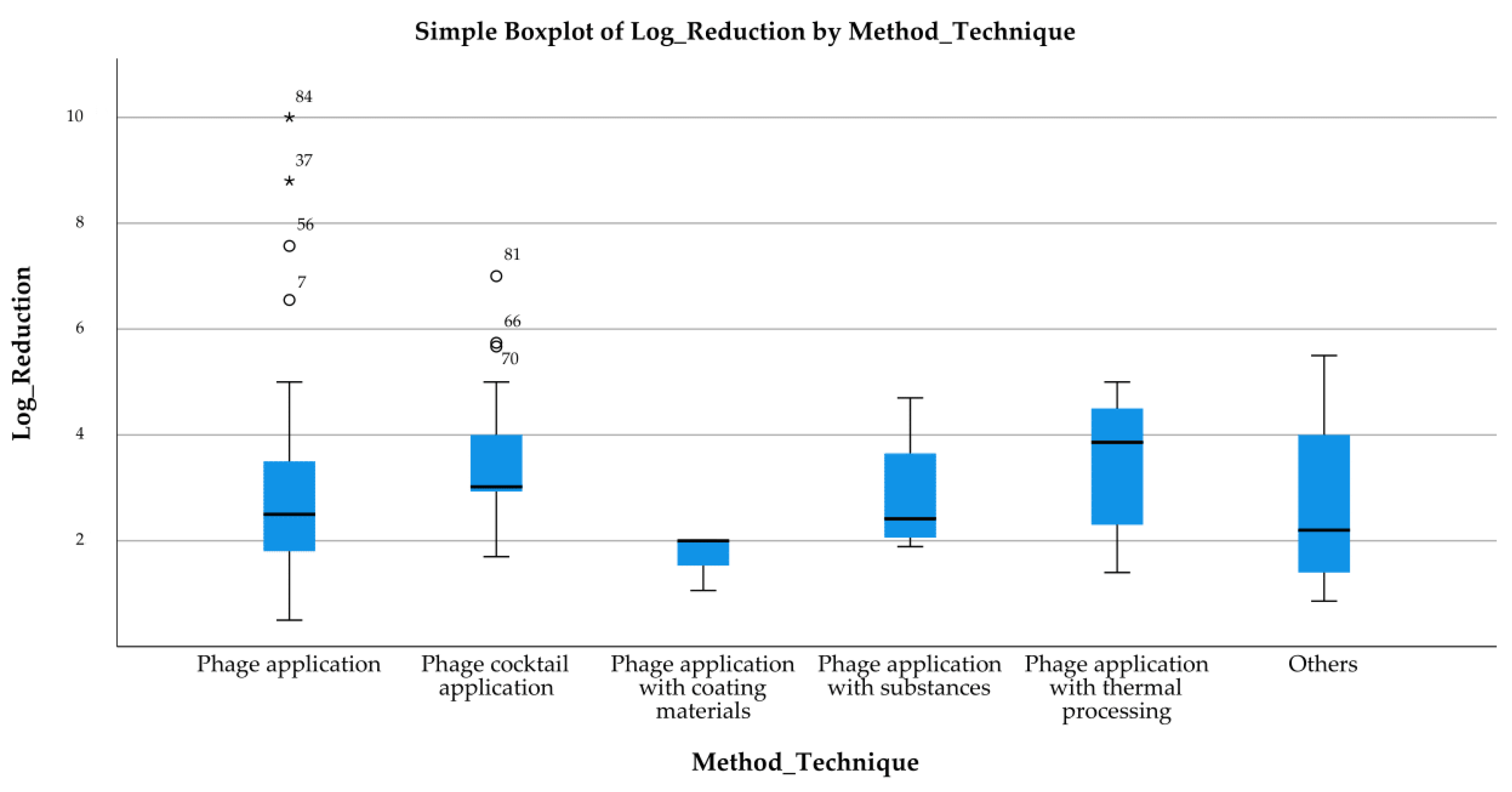

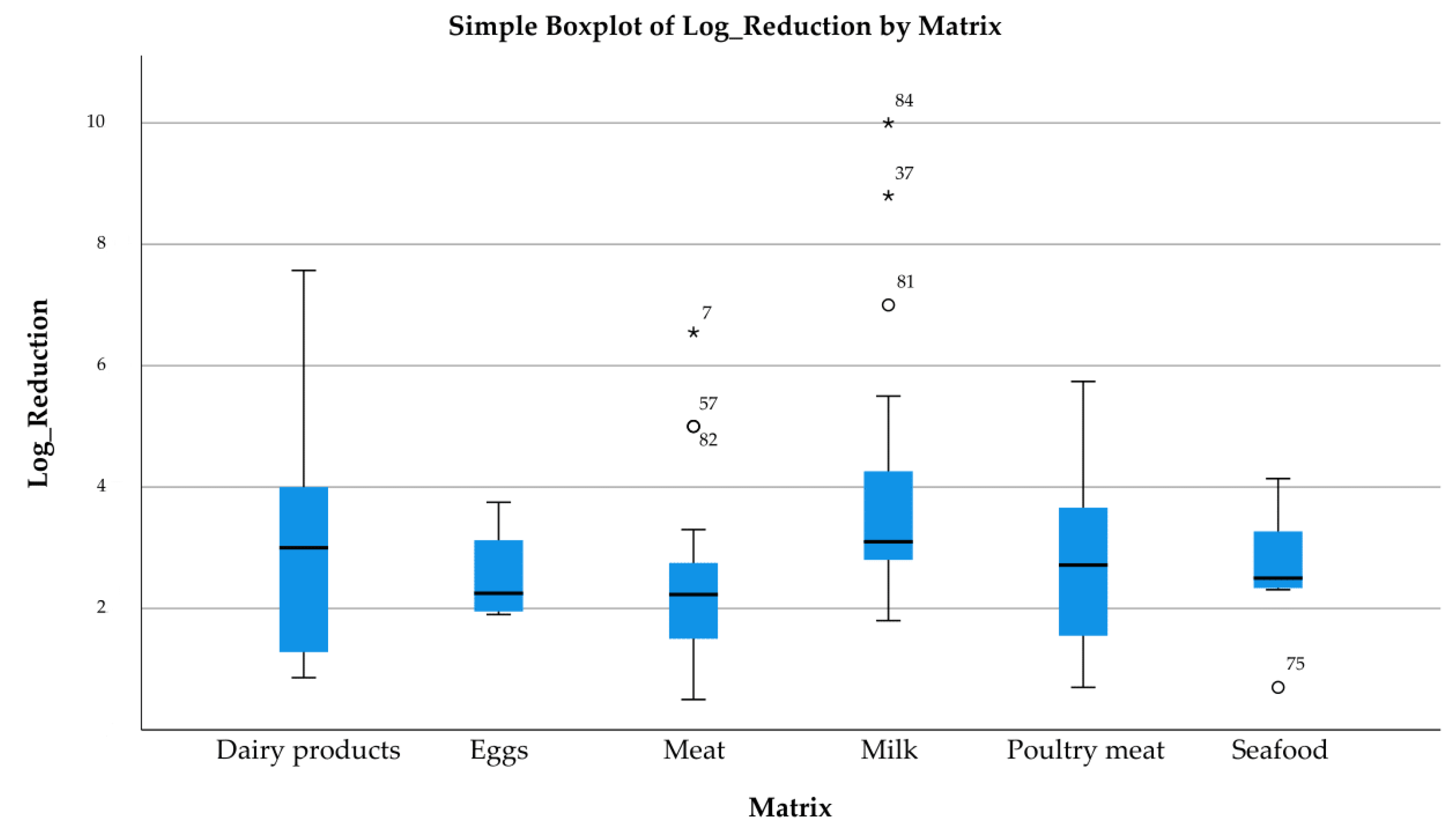
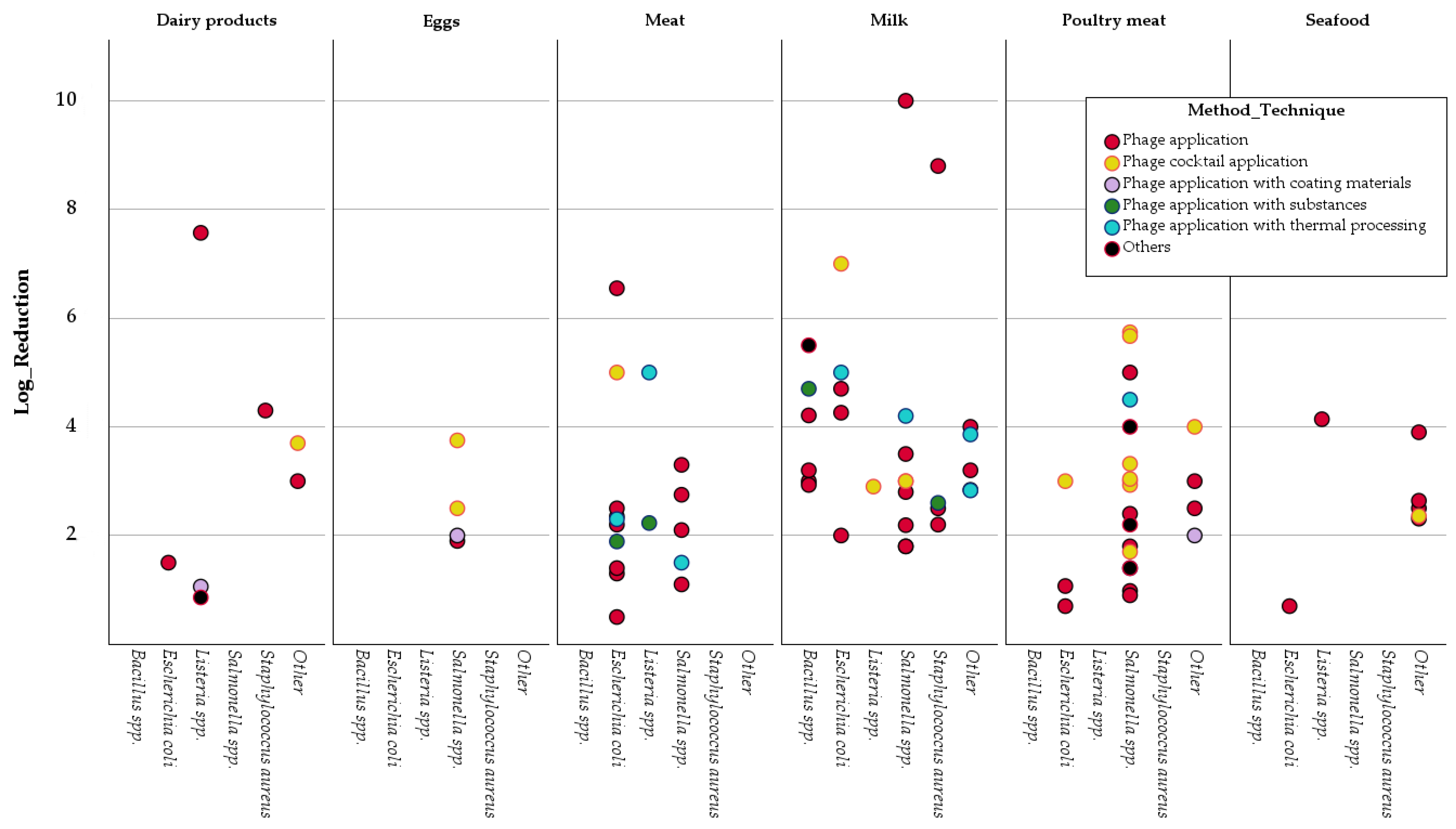
Disclaimer/Publisher’s Note: The statements, opinions and data contained in all publications are solely those of the individual author(s) and contributor(s) and not of MDPI and/or the editor(s). MDPI and/or the editor(s) disclaim responsibility for any injury to people or property resulting from any ideas, methods, instructions or products referred to in the content. |
© 2025 by the authors. Licensee MDPI, Basel, Switzerland. This article is an open access article distributed under the terms and conditions of the Creative Commons Attribution (CC BY) license (https://creativecommons.org/licenses/by/4.0/).
Share and Cite
Fokas, R.; Kotsiri, Z.; Vantarakis, A. Can Bacteriophages Be Effectively Utilized for Disinfection in Animal-Derived Food Products? A Systematic Review. Pathogens 2025, 14, 291. https://doi.org/10.3390/pathogens14030291
Fokas R, Kotsiri Z, Vantarakis A. Can Bacteriophages Be Effectively Utilized for Disinfection in Animal-Derived Food Products? A Systematic Review. Pathogens. 2025; 14(3):291. https://doi.org/10.3390/pathogens14030291
Chicago/Turabian StyleFokas, Rafail, Zoi Kotsiri, and Apostolos Vantarakis. 2025. "Can Bacteriophages Be Effectively Utilized for Disinfection in Animal-Derived Food Products? A Systematic Review" Pathogens 14, no. 3: 291. https://doi.org/10.3390/pathogens14030291
APA StyleFokas, R., Kotsiri, Z., & Vantarakis, A. (2025). Can Bacteriophages Be Effectively Utilized for Disinfection in Animal-Derived Food Products? A Systematic Review. Pathogens, 14(3), 291. https://doi.org/10.3390/pathogens14030291







